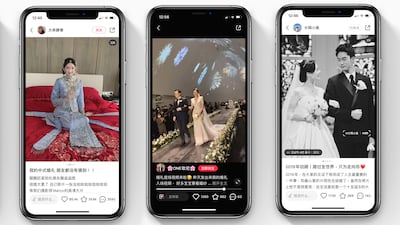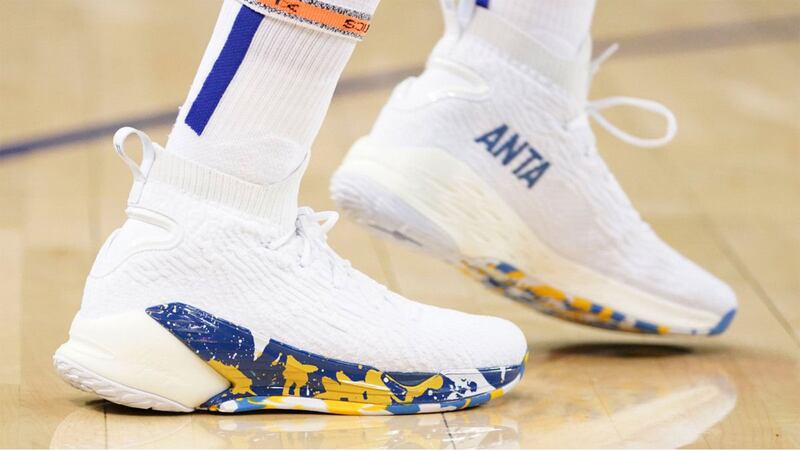
The Business of Fashion
Agenda-setting intelligence, analysis and advice for the global fashion community.

Agenda-setting intelligence, analysis and advice for the global fashion community.

Last week, a colossal wedding trade show took place in Shanghai’s National Exhibition and Convention Centre, with pavilions featuring everything from elaborate photo albums to the latest bridal manicure trends.
Attracting around 60,000 industry professionals and members of the public, the 37th edition of the biannual China Wedding Expo was no doubt impressive, but there are other ways to tap into what Chinese brides want most.
Search for “wedding dress” on Xiaohongshu and the Chinese social media app returns over three million results — think drone videos of sunset beach weddings, sweeping ceremonies in the Paris Opera house and livestreamed in-store gown try-ons. Though the matrimonial dream in China is in many ways like others around the world, there are some important differences brands should note.
As a platform dominated by millennial and Gen-Z women, it makes sense that Xiaohongshu has become a mecca for brides-to-be and unbetrothed hopefuls fantasising about their big day. But high interest in weddings among younger demographics may come as a surprise, considering that a growing number of the estimated 400 million Chinese millennials are postponing or foregoing marriage: between 2013 and 2019, the number of China’s first marriages plunged 41 percent, official data revealed.
ADVERTISEMENT

However, brands catering to China — where the market for wedding garb was worth 219.7 billion yuan ($33.9 billion) in 2019, according to iResearch — shouldn’t fret.
“The demand for wedding dresses is growing in China… production and sales are becoming a magnet for businesses,” wrote wedding industry columnist Zheng Rongxiang earlier this month. “At the same time, living standards and incomes have risen, and brides want personalisation, they want couture.”
In line with a global shift, fewer couples are choosing to wed, but those that do are spending more.
“Weddings now tend to be smaller but of better quality. The amount spent per person is higher than before,” said Cyrielle Mohara, a Shanghai-based founder of luxury events planning agency Spectrum that specialises in weddings.
Mohara’s business, which picked up last May after Beijing green lit events with up to 200 guests and allowed hotels to reopen, has returned to pre-pandemic levels. Amid rumours that China will keep its borders closed until the second half of 2022, the closest thing to a destination wedding (previously 70 percent of Spectrum’s jobs) is now the tropical province of Hainan, where Mohara says top hotels have their hands full with ceremonies and more are opening outdoor areas — increasingly in demand with younger couples — to tap into the current boom.
Other cities like Qingdao, Xiamen and Lijiang are also working to woo people planning weddings and pre-wedding photoshoots.
With spending on the rise, dresses have become even more of a focal point. “We’ve been told, ‘you can’t go out, you can’t invite all your friends’; [brides] have had to compromise on their big days in so many ways,” said Amandine Ohayon, chief executive of Barcelona-based luxury bridal brand Pronovias, which has been active in China for more than a decade.
“The one thing you won’t compromise [on] is treating yourself to a dress; the government can’t tell you which dress to wear,” added Ohayon, who saw Pronovias’ average selling price for dresses increase 7 percent since the start of the pandemic after years of remaining relatively unchanged.
ADVERTISEMENT
But with the rise of local brands like WeCouture, Shinemoda and Yuebai, global brands have their work cut out for them. “We used to have a travelling sales team so China was treated as an export market and not a strategy market,” said Ohayon. This changed in 2018, when the brand created a Chinese subsidiary and hired a local team alongside opening its Shanghai flagship. “We know we need a very strong local understanding of Chinese brides.”
Indeed, brands looking to cater to the Chinese bride face a discerning client and a competitive market filled with both global giants and local upstarts. Not only do Chinese clients want extravagant looks as minimalism trends in the West, many also want it fast; the high number of dresses in rotation — and designers competing for a spot — mean businesses need to strengthen both social media and offline strategies to make an impact. Here’s what brands need to know to get ahead.
The more dresses, the merrier. Unlike in the West, where brides typically change into two or three looks over the course of their big day, Mohara has planned up to six or seven changes in China.
Many of her clients will sport a traditional silk get-up for a Chinese ceremony in the morning, change into their white gown for the ceremony, then wear a few evening and cocktail dresses for photos, dinner, dancing and an afterparty. Brides usually opt for a red dress when they socialise and thank guests. “The least outfit changes I’ve had is four,” said Mohara. This is good news for bridal brands like Pronovias, which also design cocktail collections, but is also an opportunity for non-bridal dress designers looking to grow their China business.
Moreover, there’s the pre-wedding photoshoot: another major social media moment. According to Nicole Chang, one half of the sister duo behind Taipei-based Nicole and Felicia Couture that counts on mainland China for 70 percent of its business, brides-to-be often rent three to four gowns for the photoshoot alone.
Guochao has taken hold in bridal, too. “There’s more Chinese pride and lot of the younger brides gravitate towards local brands,” said Mohara, referring to the way that the guochao wave of patriotism and nationalism is impacting the bridal market.
Alongside Nicole and Felicia, Shinemoda and WeCouture are among the players competing with household names from abroad like Vera Wang and Pronovias for favour in the mainland market. Couture designers like Guo Pei and Hong Kong’s Kev Yiu also design intricate wedding gowns.

Local brands are well positioned to engage celebrity stylists and have better access to top KOLs (‘key opinion leaders’, or influencers in local parlance) to promote their products, said Mohara; Nicole and Felicia, for one, has been worn by Chinese actresses like Yang Mi and Fan Bingbing. But it’s not just stylists that brands need to woo; since opening its Shanghai flagship, Nicole and Felicia has cultivated a network of wedding planners and photographers, getting its gowns on brides like German-Korean pianist Gina Alice Redlinger, who married Chinese-born pianist Lang Lang in a lavish ceremony in Versailles in 2019.
ADVERTISEMENT
The ballgown isn’t out. Unlike in the West, where younger brides are increasingly opting for more practical and casual outfits for their big day, bigger is better in China. “Some brands nowadays do jumpsuits, they do pants. But I don’t see Chinese brands going for that,” said Mohara.
Instead, brides want extravagance in the form of dramatic, sculptural gowns. “They love [voluminous] dresses; big princess dresses with complex details and layering,” said Ohayon. Many Nicole and Felicia clients are adventurous: embellished, sequined dresses in a red-carpet vein are popular, said PR manager Amy Chen. “They’re willing to try colour, sparkle.”
Alongside design, it’s crucial that brands adapt their fit to Chinese clients: while most brands are demanding, Chinese ones are especially so, said Ohayon. Nicole and Felicia adjusts lengths, waistlines and bodices for the Asian market; meanwhile in May, Pronovias launched its Precious Asia collection, featuring dresses designed to the tastes and body types of Asian brides.
In one of the most digitised global markets, personalised service and getting the ideal fit is the reason why Pronovias’ business has remained rooted to its stores, added Ohayon. “Yes, maybe for the second dress, evening party dress, people will look at what’s online. But no matter what, there is nothing that can replace the experience.”
Don’t forget the KOCs. Though celebrities and KOLs are indispensable to any brand’s China strategy, bridal businesses also need to target the average bride through key opinion consumers (KOCs) or microinfluencers.
“We try to create as much content as possible to cast the widest net we can,” said Chen. This means not only sharing editorials featuring the likes of actress Angelababy and Taiwanese KOL Molly Chiang on Weibo and Xiaohongshu, but filming behind the scenes videos and inviting VIP brides to try on gowns in the brand’s flagship. Unboxing videos have also proven popular.
“[Our clients] love to see gowns on a real person, not just a model or influencer,” said Chen. “But of course we have brides who ask, ‘we saw Angelababy wear that, can i try it?’ It does speak to them as well.”
Think fast. Wedding planning can be last minute in China. “Some brides haven’t booked things three, four months before,” said Mohara. “Local designers, in terms of reactivity, are faster.”
For brands, this has been amplified by the pandemic and ongoing uncertainty around restrictions. “In China, sometimes you need a dress in eight weeks, which is very complex because all our dresses are hand-made and made to order... It’s not a T-shirt,” said Ohayon.
There are too many brands for them to choose from; they might even make their decision two months, a month before the big day.
To keep up with demand, Pronovias launched a fast-track programme with their factory partners that allowed them to deliver made-to-order dress in nine week; the brand also placed orders on dresses well in advance to keep on hold in case they needed to be amended at the 11th hour. Having warehouses in different parts of the world, including Hong Kong, also helps with shipping pieces to brides in a rush.
Nicole and Felicia’s Chang sees this more with her brand’s rental business, which makes up the bulk of her orders. “There are too many brands for them to choose from; they might even make their decision two months, a month before the big day,” said Yu.
Re-think sales, rental and second-hand. While second-hand and rental dresses have gained popularity in the West, the opposite is happening in China, according to Ohayon, thanks in part to higher disposable incomes. “Brides want to own their dream dress and have it made especially for them,” she said, listing the high demand for Pronovias’ recent sales-only Vera Wang partnership as evidence.
This does depend, of course, on the price tag. At 20,000 yuan ($3,081), Nicole and Felicia’s rentals aren’t cheap, but buying one of the brand’s ball gowns costs between 80,000 and 100,000 RMB ($15,407). “It’s less of an option,” said Yu. Most multi-brand boutiques and local designers provide rental options.
And despite the gradual acceptance of pre-loved fashion and online second-hand marketplaces, a mainstream Chinese digital bridal rental player has yet to emerge, said Mohara. “The industry is largely offline aside from marketing — I don’t see brides choosing dresses on the internet.”
时尚与美容
FASHION & BEAUTY

Chinese Sportswear Giant Anta Unveils Ambitious Five-Year Plan
Anta unveiled its plan for the next five years — at an investor day last week — and its “Lead to Win” strategy for the next 24 months of rapid growth, as it looks to overtake Adidas as the world’s second-largest sportswear company by market cap. Chairman and chief executive Ding Shizhong, said that China’s third to fifth-tier cities will be the main battleground for competition among sportswear players, and Anta will remain focused on the mass market. Ding also set goals to achieve compound annual revenue growth (CAGR) of 18 to 25 percent over the next five years. The sportswear company will focus on accelerating its shift to core channels and direct-to-consumer upgrades while continuing its digital transformation. (BoF)
Nike Shares Lose Out to Chinese Sneaker Rivals After Xinjiang Cotton Boycott
Rising tensions over accusations of forced labour in Xinjiang has become a threat for global companies operating in China. The Chinese consumers’ move away from foreign brands has seen firms like Anta Sports and Li Ning gain market share despite supporting the use of Xinjiang’s contentious materials. With Anta as an official supplier for the Beijing 2022 Winter Olympics, the shift to local businesses is likely to continue to grow. The gains for smaller companies have also been rising, as 361 Degrees’ shares jumped 91 percent and Xtep International’s surged 248 percent in the same period. (Bloomberg)
科技与创新
TECH & INNOVATION

ByteDance Said to Have Met With Officials Over Data Security
The Chinese tech giant and owner of TikTok is working to ensure it complies with data security requirements after meeting with governmental officials earlier this year, according to a person familiar with the matter. This comes after ByteDance kicked off initial preparations for an IPO of its domestic assets, Bloomberg News reported in April. Prior to Didi Global Inc’s IPO which sparked regulatory backlash, ByteDance’s considerations to go public have been in flux as the company has approached any potential IPO with caution. (Bloomberg)
消费与零售
CONSUMER & RETAIL

JD.com Invests $300 Million in Chinese Retailer KK Group
China-based KK Group, which focuses on mass-market consumer goods popular with Gen-Z consumers, recently closed a new $300 million funding round, led by JD.com, which values the business at $3 billion. Among the brands owned by the group, multi-brand beauty retailer The Colorist and lifestyle shop KKV both have over 300 stores nationwide, while X11, its trendy toy retail space launched this year, opened its first flagship store in Shanghai. The investment has been viewed by analysts as a further development in collaboration amongst one of China’s biggest e-commerce players and a fast-growing offline upstart. (BoF)
China Garment Industry Revenues, Profits Continue to Rise
Official government data from January to May has shown the combined operating revenue of 12,451 major enterprises in China’s garment sector reached 525.1 billion yuan ($81.1 billion), up 13.3 percent from the same period last year, according to the Ministry of Industry and Information Technology (MIIT). The latest statistics also show China’s exports of garments and accessories surged 48.3 percent year on year to $56.6 billion. (BoF)
China Plans Security Checks for Tech Companies Listing Overseas
China moved on Saturday toward requiring domestic tech companies to submit to a cybersecurity check-up before going public on overseas stock exchanges. The revised rules will see a mandatory security review on any business possessing information on more than one million users, which seeks to list its shares abroad. Materials related to their IPOs, procurement documents and contracts would need to be submitted prior to listing overseas. The revision also listed two extra risks to the list: “stolen, leaked, damaged and illegally exploited or moved overseas,” and that data could be “influenced, controlled or maliciously exploited by foreign governments.” (New York Times)
政治,经济与社会
POLITICS, ECONOMY, SOCIETY

China Cracks Down on Didi and Business Elites Over Data Security
Chinese regulators ordered Didi to shut down signups for further users after it came under fire following its blockbuster IPO in New York. The regulators said the app should be pulled from Chinese app stores due to concerns for national security and protecting the data of Chinese users. Weibo users called the app a “traitor” and urged further action from the government. The actions have come as part of a wider crackdown by China against its homegrown tech companies. In particular, this shift began in November with regulators disapproval of Ant Group’s IPO — at the time many viewed the move as inevitable to stop Jack Ma’s monopoly. The government has made it clear that it will continue to be strict about keeping data within its borders while pressuring its tech elites to show loyalty to the request. (New York Times)
Hong Kong Democracy Supporters Lead Resistance Via Shopping
With China’s introduction of the national security law to stop pro-democracy protests, opposition groups are now calling for a boycott of companies that align with Beijing. “Where you choose to spend your money is a decision you make, and that will have an impact on society,” said Cynthia Wong, a university employee who frequents a pro-democracy market. Several apps — including Mee-Punish club — have been created to help shoppers identify pro-democracy businesses. One of the app’s developers told a local media outlet that it has 4,000 shops registered on its platform, with 170,000 member customers. (Wall Street Journal)
News items compiled by Darcey Sergison
China Decoded wants to hear from you. Send tips, suggestions, complaints and compliments to our Shanghai-based Asia Correspondent casey.hall@businessoffashion.com.
With consumers tightening their belts in China, the battle between global fast fashion brands and local high street giants has intensified.
Investors are bracing for a steep slowdown in luxury sales when luxury companies report their first quarter results, reflecting lacklustre Chinese demand.
The French beauty giant’s two latest deals are part of a wider M&A push by global players to capture a larger slice of the China market, targeting buzzy high-end brands that offer products with distinctive Chinese elements.
Post-Covid spend by US tourists in Europe has surged past 2019 levels. Chinese travellers, by contrast, have largely favoured domestic and regional destinations like Hong Kong, Singapore and Japan.